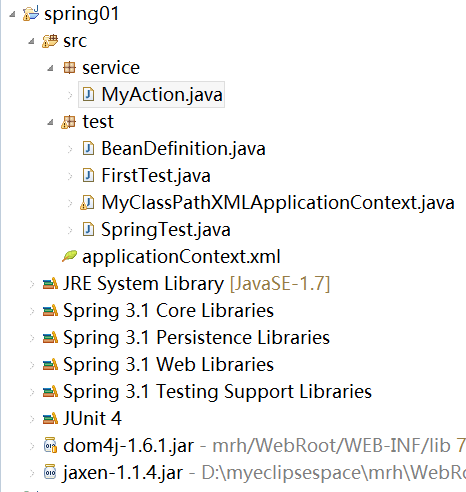project目录
MyClassPathXMLApplicationContext读取xml,以及实例化bean。
因为是一开始实例化配置文件所有bean,所以需要构造器完成这些工作。
package test; import java.net.URL; import java.util.ArrayList; import java.util.HashMap; import java.util.List; import java.util.Map; import org.dom4j.Document; import org.dom4j.Element; import org.dom4j.XPath; import org.dom4j.io.SAXReader; public class MyClassPathXMLApplicationContext { private List<BeanDefinition> beanDefines = new ArrayList<BeanDefinition>(); private Map<String, Object> sigletons = new HashMap<String, Object>(); public MyClassPathXMLApplicationContext(String filename){ this.readXML(filename); this.instanceBeans(); } /** * 完成bean的实例化 */ private void instanceBeans() { for(BeanDefinition beanDefinition : beanDefines){ try { if(beanDefinition.getClassName()!=null && !"".equals(beanDefinition.getClassName().trim())) sigletons.put(beanDefinition.getId(), Class.forName(beanDefinition.getClassName()).newInstance()); } catch (Exception e) { e.printStackTrace(); } } } /** * 读取xml配置文件 * @param filename */ private void readXML(String filename) { SAXReader saxReader = new SAXReader(); Document document=null; try{ URL xmlpath = this.getClass().getClassLoader().getResource(filename); document = saxReader.read(xmlpath); Map<String,String> nsMap = new HashMap<String,String>(); nsMap.put("ns","http://www.springframework.org/schema/beans");//加入命名空间 XPath xsub = document.createXPath("//ns:beans/ns:bean");//创建beans/bean查询路径 xsub.setNamespaceURIs(nsMap);//设置命名空间 List<Element> beans = xsub.selectNodes(document);//获取文档下所有bean节点 for(Element element: beans){ String id = element.attributeValue("id");//获取id属性值 String clazz = element.attributeValue("class"); //获取class属性值 BeanDefinition beanDefine = new BeanDefinition(id, clazz); beanDefines.add(beanDefine); } }catch(Exception e){ e.printStackTrace(); } } /** * 获取bean实例 * @param beanName * @return */ public Object getBean(String beanName){ return this.sigletons.get(beanName); } }
bean的定义类:
package test; public class BeanDefinition { private String id; private String className; public BeanDefinition(String id, String className) { this.id = id; this.className = className; } public String getId() { return id; } public void setId(String id) { this.id = id; } public String getClassName() { return className; } public void setClassName(String className) { this.className = className; } }
测试类:
package test; import org.junit.BeforeClass; import org.junit.Test; import service.MyAction; public class SpringTest { @BeforeClass public static void setUpBeforeClass() throws Exception { } @Test public void instanceSpring(){ MyClassPathXMLApplicationContext ctx = new MyClassPathXMLApplicationContext("applicationContext.xml"); MyAction ma = (MyAction)ctx.getBean("myaction"); ma.sayHello(); } }
applicationContext.xml:
<?xml version="1.0" encoding="UTF-8"?> <beans xmlns="http://www.springframework.org/schema/beans" xmlns:xsi="http://www.w3.org/2001/XMLSchema-instance" xsi:schemaLocation="http://www.springframework.org/schema/beans http://www.springframework.org/schema/beans/spring-beans-3.1.xsd"> <bean id = "myaction" class = "service.MyAction"></bean> </beans>